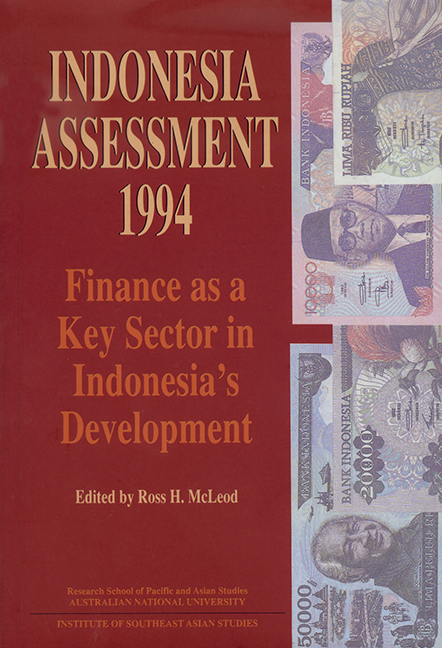Book contents
- Frontmatter
- Contents
- Tables, figures, appendices
- Foreword
- Glossary
- Contributors
- Acknowledgements
- 1 Introduction
- PART A ECONOMIC AND POLITICAL DEVELOPMENTS
- PART B FINANCE AS A KEY SECTOR IN INDONESIA'S DEVELOPMENT
- I The Reform Process
- II Monetary and Exchange Rate Policy
- III Banking Sector Reforms
- IV Domestic and International Capital Markets
- V Small-scale Finance
- 16 Small-scale finance: lessons from Indonesia
- 17 The cooperative rural finance program in Indonesia
- References
- Index
16 - Small-scale finance: lessons from Indonesia
from V - Small-scale Finance
Published online by Cambridge University Press: 21 October 2015
- Frontmatter
- Contents
- Tables, figures, appendices
- Foreword
- Glossary
- Contributors
- Acknowledgements
- 1 Introduction
- PART A ECONOMIC AND POLITICAL DEVELOPMENTS
- PART B FINANCE AS A KEY SECTOR IN INDONESIA'S DEVELOPMENT
- I The Reform Process
- II Monetary and Exchange Rate Policy
- III Banking Sector Reforms
- IV Domestic and International Capital Markets
- V Small-scale Finance
- 16 Small-scale finance: lessons from Indonesia
- 17 The cooperative rural finance program in Indonesia
- References
- Index
Summary
For a labour-abundant country like Indonesia, those parts of current industrialisation strategy which seek to develop labour-intensive and, in particular, export-oriented industries seem the most appropriate, as it is not clear that the government's present strategies as a whole can guarantee absorption of sufficient numbers of people into the production process. The manufacturing sector can be sub-divided into modern and traditional sectors, in which different technologies are employed (Thee 1993). Thus in 1986, medium and large enterprises (MLEs) accounted for 82 per cent of total value added, but employed only 33 per cent of manufacturing employment. On the other hand, the household and cottage enterprise sector (HCE) and the small enterprise (SE) sectors contributed only 11 per cent and 7 per cent, respectively, of total manufacturing value added, and yet employed no less than 53 per cent and 14 per cent, respectively, of manufacturing workers.
To achieve a more balanced pattern of industrialisation, financial policies to promote SEs and HCEs should go hand in hand with support for the development of efficient, labour-intensive MLEs. Government assistance is required to improve the productivity of SEs and HCEs, and thus to increase their competitiveness in the market. The challenge of creating a more efficient manufacturing sector overall is daunting.
One key factor confronting the nation in its efforts to improve productivity in SEs and HCEs is the low level of educational achievement generally, and the shortage of technological and managerial know-how in particular. To overcome this handicap, huge government investments are required in education and health, for both the urban and the rural populations. These long-term investments will create a more productive workforce, which is an indispensable prerequisite for a modern industrialised society.
Overcoming financial constraints
A second major handicap for SEs and HCEs is their lack of capital, which is aggravated by banks' reluctance to finance this sector. In several surveys of small enterprises, lack of working capital has been cited frequently as one of the most pressing constraints on their development (Kilby and Liedholm 1986; Wickramanayake 1988).
- Type
- Chapter
- Information
- Indonesia Assessment 1994Finance as a Key Sector in Indonesia's Development, pp. 292 - 313Publisher: ISEAS–Yusof Ishak InstitutePrint publication year: 1994

